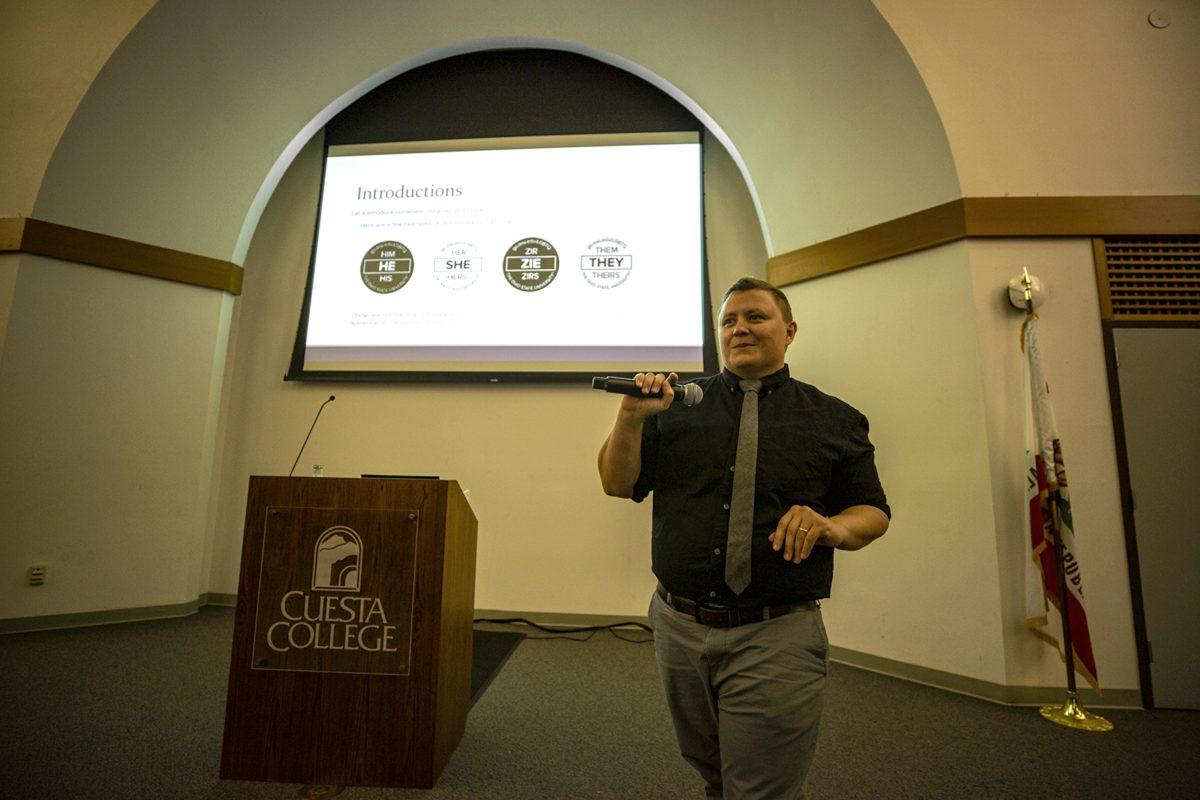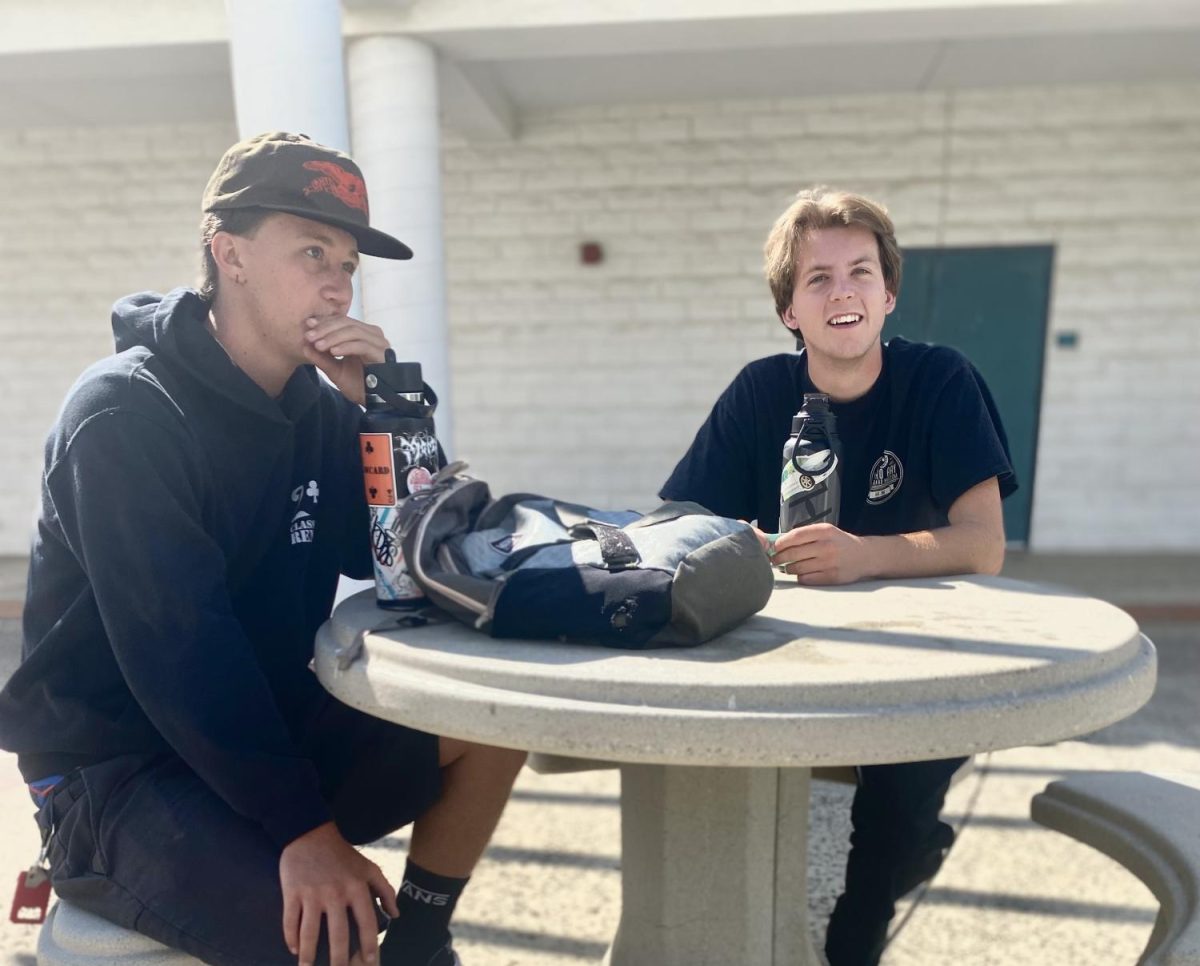Faculty, staff and students from both Cuesta College and its North County campus came together to discuss and bring to light some of the issues facing the LGBTQ+ community.
Cuesta College put together a four hour Safe Zone training to talk about homophobia, sexism and how to be allies for the gay and lesbian students who attend the college, as well as how to interact properly within a diverse community.Â
“My pronouns are; He, Him and His,†said Appy Fryckenburg, keynote speaker. “My name is Appy like in Happy, but without the H. Be prepared to have fun, laugh, be (un)comfortable, learn basic terms of the LGBTQ+ community, understand allyship and what it stands for, get to know yourself and your neighbor a little better and leave with foundational knowledge of the LGBTQ and the acknowledgement that you completed the Cuesta College campus Safe Zone Training.â€
Frykenberg has focused on support and advocacy of the LGBTQ+ community throughout his career. His current position is Social Justice Education Program Specialist of the Student Life Multicultural Center at The Ohio State University. Â
In the eyes of Teri Sherman, an Academic Counselor for 21 years at Cuesta College and who recently did a sabbatical focusing on LGBTQ+ and gender studies, her passion is to create a safe and welcoming environment for all LGBTQ+ students at Cuesta College. That’s her goal with the four hour training session.  Â
“The primary mission of the Safe Zone training is to create a more welcoming and more inclusive campus environment at Cuesta, to strengthen community and to encourage networking among faculty, staff and students toward the goal of supporting the diverse individuals and communities with minoritized sexual and/or gender identities,†Sherman said.
Frykenberg views this training as a living document in that everytime a Safe Zone meeting occurs, the mood is always different because of the diversity of the people involved. It nevers looks the same, just like gender identity, and it reaches more and more people from both sides of the spectrum.

The message they are trying to get across to the public is how to properly engage with a gender neutral person, and how to engage with them by using the proper pronouns. Setting the tone and giving out the appropriate gender specific pronoun is important because it allows the other person the ability to identify the actual gender and use the correct pronouns.
What the training is making clear to those that attend is to avoid assumptions.Â
“I can tell you that when a queer walks into a room or a classroom, they looking for signs that they are accepted and belong in there,†Appy said. Â
Appy acknowledged that information from the training may seem new to a majority of the participants, but found that it created a positive place to ask those questions. Knowledge is power, and that is why Appy considers it important for students, and especially faculty and staff, to attend seminars like this to be re-educated in how to approach people of neutral gender. Â
The LGBTQ+ community still generally feels at risk within the public. This includes community colleges. Â
“The best way to know that teachers are educating effectively, is if they are helping their students connect with what they are teaching in real life, that is the key to making a difference and being constructive,†Appy said. “Until a person of neutral gender feels completely safe and receives a signal from someone that is okay to identify themselves the game of being within able to identified or not continues to play in the back of the mind over and over.â€Â Â
Frykenberg explained the importance of being proactive, and taking both the initiative to be welcoming and embrace the LGBTQ+ community. If not, the damage comes in the form of being stuck in a cognitive space of not knowing how to be identifyied in the hetero-sexual world.  Â
The training also touched on the subject of making Cuesta College an even more welcoming environment. The strategies are numerous in regards to handling sensitive subjects, which goes beyond addressing pronouns and applies to a whole set of mannerisms in approaching gender neutrals.
“Now it is time for statistics,†Appy said. “According to the national survey, studies show that 8 percent to 10 percent of all college students identify as lesbian, gay, bisexual or trannsgender and 16 percent have a member of their family who is LGBTQ+.â€Â Â
Appy stressed for everyone to wake up and look within their classrooms, faculty and staff to be mindful of how deeply impacted society is by numbers of students within the sector that fall under the category. According to Appy’s data, if Cuesta College has 9,000 students, at least 900 might in some way label themselves as LGBTQ+.
Appy said students who feel unsafe while attending college become less engaged in classroom and campus activities, and tend to have a lower G.P.A. averages. An estimated 61.6 percent of the LGBTQ+ students drop out of college and 12 percent are fearing for their safety on the college campus in which they are attending.
In Abby’s opinion, those numbers are unacceptable. He stresses that although these numbers are dated back to 2015, they seem low and are expected to rise in 2020. Â
Another reason the percentages may be low in the LGBTQ+ community for college campuses is due to the fact that it is difficult to track the community itself.Â
“Students may feel uncomfortable filling out paperwork and identifying themselves as gender neutral, for fear of their safety,†Abby said. “Their parents may be standing right next to them while they are filling out their college paperwork and choose not to be identified.â€Â Â
In the trans-masculine, trans-feminine and GNC (gender non-conforming) populace, 58.7 percent experience derrogatory remarks while on campus and 19.1 percent drop out of thier college courses due to an unsafe educational environment. Overall, 47 to 55 percent of all LGBTQ+ students felt ignored in their classrooms, and 33 percent (LGBTQ+) to 40 percent (trans) of all students are leaving their institutions due to the types of discrimination they experience on campus.Â
“I know these are pretty hard figures, but I like to hammer home the fact that we get a lot of stereotypes about the LGBTQ+ community,†Appy said. “That is why I like to back it up with cold hard facts.â€Â   Â
Appy went on to jokingly admit that people are complicated, and terminology is important within the LGBTQ+ community. Differentiating between sexual orientation and sexual identity can be confusing because of attributing certain patterns of attraction: emotional, romantic, sexual, spiritual and intellectual. The patterns don’t apply to everyone involved. Â
That knowledge alone is one of the key factors in respecting the gender safety zone.
“We attach terms to how we are attracted to people and don’t normally align them with what other people think it should be,†Appy said. “That terminology describes how we are attracted and that is how we identify with sexual identity.â€Â
The training, which was a first of its kind for Cuesta College and lasted about four hours, brought awareness and a new way of thinking for everyone involved. The safe training zone was a time for participants to role play and speak to each other in a gender neutral manner. This gave the audience a moment to practice and an opportunity to really understand how difficult it is to converse with gender neutral appropriate pronouns. Everyone needs to be educated on the formalites, in order to be respectful to the LGBTQ+ community and how they prefer to be identified. For everyone involved in the training there was a sense of excitement to being able to engage in an event that embraced unity and inclusion at Cuesta College.
“Ultimately, we would like to see all staff and faculty attend a Safe Space or Safe Zone training so that we can serve as campus allies,†Sherman said. Â
Allies serve a critical role in Cuesta College’s mission of connecting and supporting the needs of a diverse student body. The goal at Cuesta College is to work on joint efforts involving staff, faculty, management and students to help promote the acceptance, inclusion and celebration of multiple types of diversity.
The main reason for safe training is to understand the terminology that goes with the individuals’ gender expression. Trainings such as this possibly provide a clearer understanding and sensitivity to the needs of the LQBTQ+ community within the college campus. By having the knowledge and education to interact with students of diversity, a more welcoming environment can be established in both the educational institutions and public sectors alike.















Michael Cohen • Dec 1, 2019 at 5:10 pm
Reallly . ggreeate stuf
I love IT